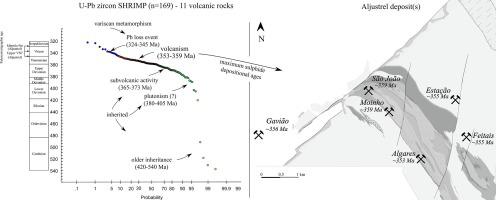Ore Geology Reviews ( IF 3.3 ) Pub Date : 2021-04-06 , DOI: 10.1016/j.oregeorev.2021.104147 João Lains Amaral , Ana Rita Solá , Telmo M. Bento dos Santos , Colombo C.G. Tassinari , João Gonçalves

|
A geochronological study using SHRIMP U-Pb analysis of zircon grains has been conducted to date felsic volcanic rocks hosting the six massive sulphide deposits of the giant Aljustrel mining district in the Iberian Pyrite Belt. A multiple method age calculation approach was used to validate and ponder calculated Concordia ages (emplacement and inherited), which included weighted average, probability density peak(s), Tuff Zirc and Unmix functions. This approach was particularly useful to interpret the wide continuous single U-Pb ages (320–405 Ma) recorded in the Aljustrel volcanic rocks.
The volcanic pile (>250 m) that hosts the Aljustrel deposits was emplaced between 359 and 353 Ma. Upper Devonian inheritance, representing subvolcanic activity, is well-represented in the volcanic rocks of Aljustrel (373–365 Ma). Older Devonian inherited zircon ages at 405 Ma, 388 Ma and 380 Ma were retrieved, hypothetically representing deep plutonism or other melting episodes, which suggests a long-lasting (~50 Ma) magmatic activity in the Aljustrel district. Older pre-Devonian inherited ages, uppermost Silurian and early to late Cambrian, and post-emplacement ages (~330–345 Ma) were also detected, with the latter reflecting Pb loss most likely driven by the main Variscan orogenic event.
Maximum ages obtained for the volcanic rocks in the different deposits open the possibility that the last pulses of volcanic activity and subsequent deposition of the massive sulphides were diachronic in the different Aljustrel sub-basins. Additionally, results imply that, contrary to previously assumed, Gavião and São João-Moinho deposits are probably not the same ore lens disrupted by tardi-Variscan faults. This opens new opportunities for mining exploration and targeting in the Aljustrel district and points out the importance of high-resolution geochronological studies in mining and brownfield areas.
中文翻译:

U-Pb锆石SHRIMP年代久远的岩浆环境及其火山成年期:来自容纳巨大的Aljustrel矿床(伊比利亚黄铁矿带)的硫化物矿石的长英质火山岩的见解
迄今为止,已经使用SHRIMP U-Pb分析锆石进行了年代学研究,迄今为止,长英质火山岩具有伊比利亚黄铁矿带中巨大的Aljustrel矿区的六个块状硫化物矿床。使用多种方法的年龄计算方法来验证和考虑计算的Concordia年龄(安置和继承),其中包括加权平均值,概率密度峰值,Tuff Zirc和Unmix函数。这种方法对于解释Aljustrel火山岩中记录的宽连续单个U-Pb年龄(320-405 Ma)特别有用。
容纳Aljustrel矿床的火山桩(> 250 m)被安置在359至353 Ma之间。代表亚火山活动的上泥盆纪继承性在Aljustrel(373–365 Ma)的火山岩中得到了很好的体现。泥盆纪遗留的锆石年龄分别为405 Ma,388 Ma和380 Ma,据推测代表深部的岩屑作用或其他熔融事件,这表明Aljustrel地区的岩浆活动持续时间长(约50 Ma)。还发现了较晚的德文纪前遗留年龄,最高志留纪和寒武纪早期至晚期,以及侵位后年龄(〜330-345 Ma),后者反映了铅的损失,这很可能是由主要的瓦里斯卡造山事件驱动的。
不同沉积物中火山岩获得的最大年龄开辟了以下可能性:在不同的Aljustrel子盆地中,火山活动的最后脉冲和随后大量块状硫化物的沉积是历时性的。另外,结果暗示,与先前的假设相反,Gavião和SãoJoão-Moinho矿床可能与受tardi-Variscan断层破坏的矿石透镜不同。这为Aljustrel地区的采矿勘探和目标开发提供了新的机会,并指出了在采矿和棕地地区进行高分辨率地质年代研究的重要性。



























 京公网安备 11010802027423号
京公网安备 11010802027423号